Hospitality Operation Management Report: Demand, Pricing, and Analysis
VerifiedAdded on 2021/01/01
|13
|4879
|284
Report
AI Summary
This report provides a comprehensive analysis of hospitality operation management, using the Hilton Hotel as a case study. It explores the nature of hospitality products and services, examining room divisions, food and beverage, and conference facilities. The report delves into the factors influencing demand, such as seasonality and economic conditions, while also comparing customer profiles and their expectations. Key stages in product and service development are outlined, including idea generation, concept testing, and commercialization, with a focus on customer perception and merchandising opportunities. The report also examines pricing methods, revenue generation, performance measures, and business analysis approaches within the hospitality sector. The content is suitable for students looking for information on hospitality management on Desklib.
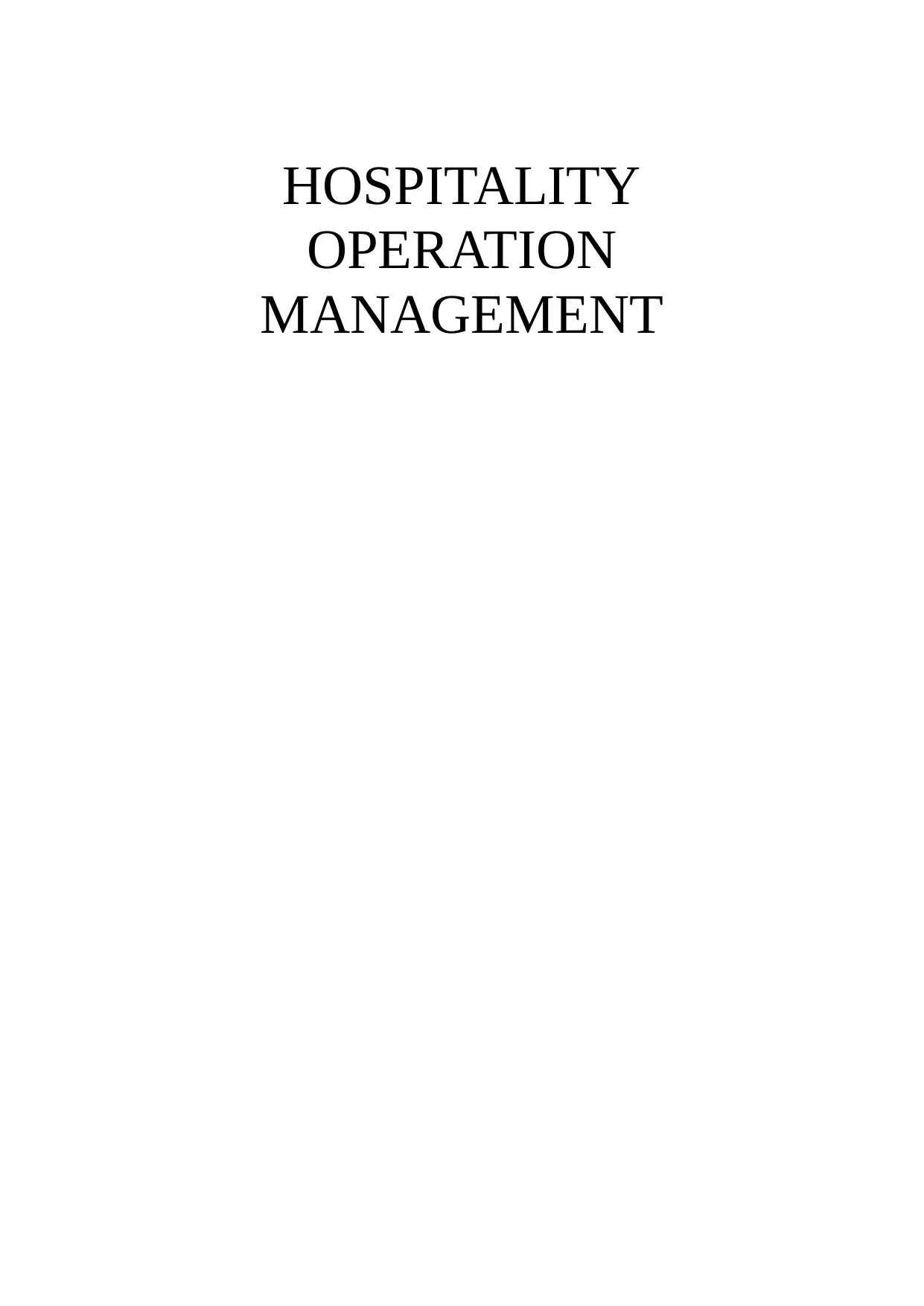
HOSPITALITY
OPERATION
MANAGEMENT
OPERATION
MANAGEMENT
Paraphrase This Document
Need a fresh take? Get an instant paraphrase of this document with our AI Paraphraser
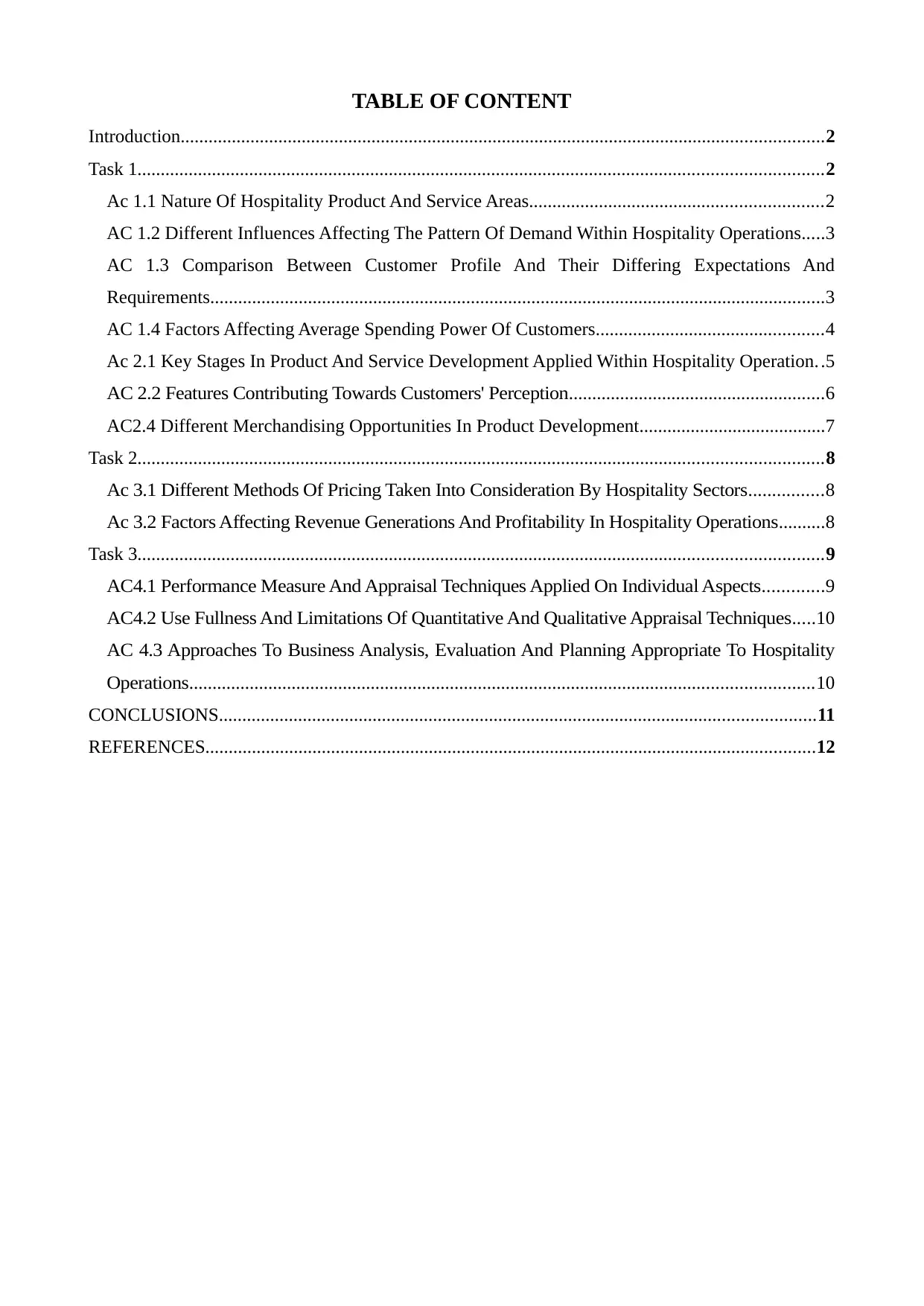
TABLE OF CONTENT
Introduction..........................................................................................................................................2
Task 1...................................................................................................................................................2
Ac 1.1 Nature Of Hospitality Product And Service Areas...............................................................2
AC 1.2 Different Influences Affecting The Pattern Of Demand Within Hospitality Operations.....3
AC 1.3 Comparison Between Customer Profile And Their Differing Expectations And
Requirements....................................................................................................................................3
AC 1.4 Factors Affecting Average Spending Power Of Customers.................................................4
Ac 2.1 Key Stages In Product And Service Development Applied Within Hospitality Operation..5
AC 2.2 Features Contributing Towards Customers' Perception.......................................................6
AC2.4 Different Merchandising Opportunities In Product Development........................................7
Task 2...................................................................................................................................................8
Ac 3.1 Different Methods Of Pricing Taken Into Consideration By Hospitality Sectors................8
Ac 3.2 Factors Affecting Revenue Generations And Profitability In Hospitality Operations..........8
Task 3...................................................................................................................................................9
AC4.1 Performance Measure And Appraisal Techniques Applied On Individual Aspects.............9
AC4.2 Use Fullness And Limitations Of Quantitative And Qualitative Appraisal Techniques.....10
AC 4.3 Approaches To Business Analysis, Evaluation And Planning Appropriate To Hospitality
Operations......................................................................................................................................10
CONCLUSIONS................................................................................................................................11
REFERENCES...................................................................................................................................12
Introduction..........................................................................................................................................2
Task 1...................................................................................................................................................2
Ac 1.1 Nature Of Hospitality Product And Service Areas...............................................................2
AC 1.2 Different Influences Affecting The Pattern Of Demand Within Hospitality Operations.....3
AC 1.3 Comparison Between Customer Profile And Their Differing Expectations And
Requirements....................................................................................................................................3
AC 1.4 Factors Affecting Average Spending Power Of Customers.................................................4
Ac 2.1 Key Stages In Product And Service Development Applied Within Hospitality Operation..5
AC 2.2 Features Contributing Towards Customers' Perception.......................................................6
AC2.4 Different Merchandising Opportunities In Product Development........................................7
Task 2...................................................................................................................................................8
Ac 3.1 Different Methods Of Pricing Taken Into Consideration By Hospitality Sectors................8
Ac 3.2 Factors Affecting Revenue Generations And Profitability In Hospitality Operations..........8
Task 3...................................................................................................................................................9
AC4.1 Performance Measure And Appraisal Techniques Applied On Individual Aspects.............9
AC4.2 Use Fullness And Limitations Of Quantitative And Qualitative Appraisal Techniques.....10
AC 4.3 Approaches To Business Analysis, Evaluation And Planning Appropriate To Hospitality
Operations......................................................................................................................................10
CONCLUSIONS................................................................................................................................11
REFERENCES...................................................................................................................................12
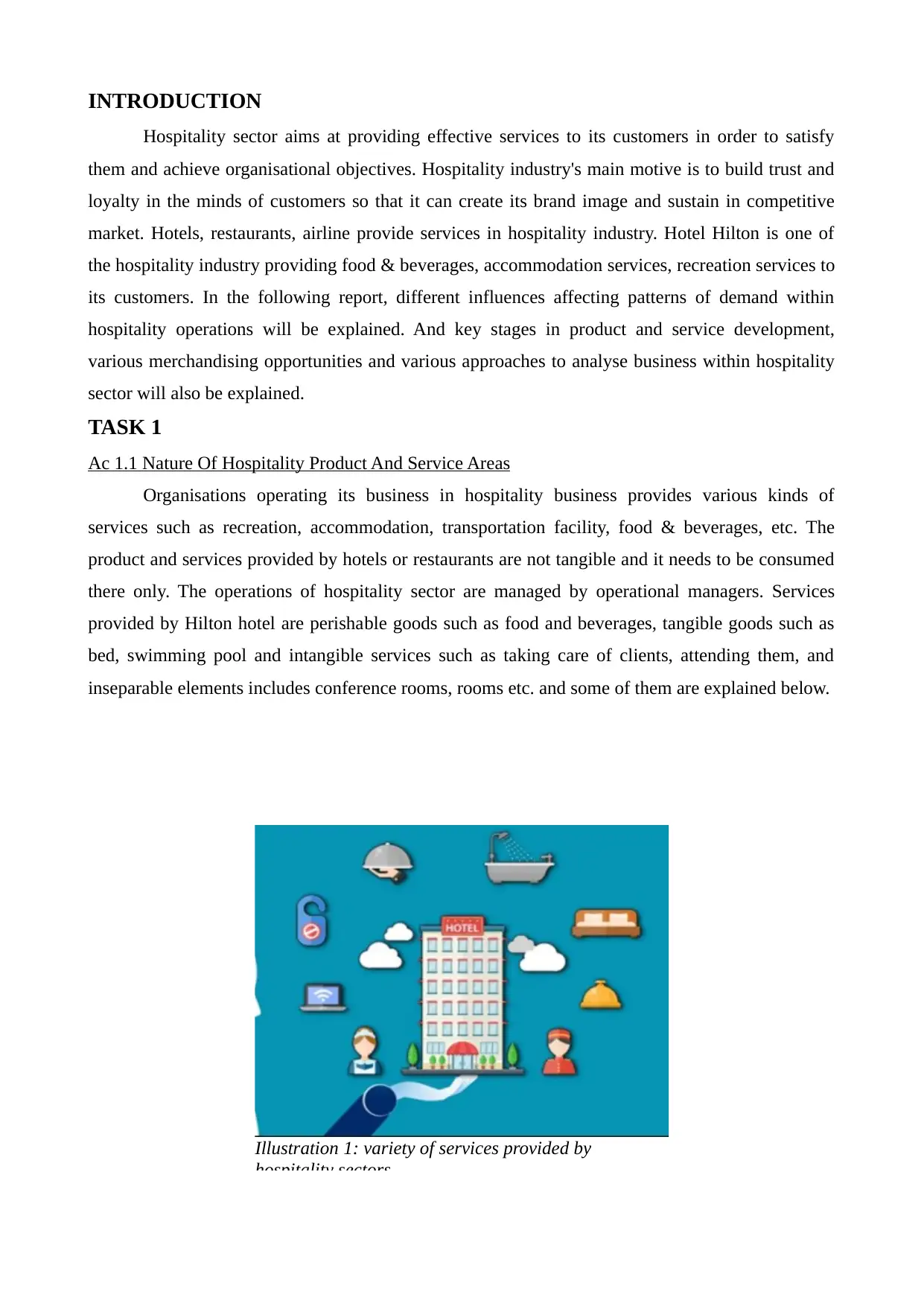
INTRODUCTION
Hospitality sector aims at providing effective services to its customers in order to satisfy
them and achieve organisational objectives. Hospitality industry's main motive is to build trust and
loyalty in the minds of customers so that it can create its brand image and sustain in competitive
market. Hotels, restaurants, airline provide services in hospitality industry. Hotel Hilton is one of
the hospitality industry providing food & beverages, accommodation services, recreation services to
its customers. In the following report, different influences affecting patterns of demand within
hospitality operations will be explained. And key stages in product and service development,
various merchandising opportunities and various approaches to analyse business within hospitality
sector will also be explained.
TASK 1
Ac 1.1 Nature Of Hospitality Product And Service Areas
Organisations operating its business in hospitality business provides various kinds of
services such as recreation, accommodation, transportation facility, food & beverages, etc. The
product and services provided by hotels or restaurants are not tangible and it needs to be consumed
there only. The operations of hospitality sector are managed by operational managers. Services
provided by Hilton hotel are perishable goods such as food and beverages, tangible goods such as
bed, swimming pool and intangible services such as taking care of clients, attending them, and
inseparable elements includes conference rooms, rooms etc. and some of them are explained below.
Illustration 1: variety of services provided by
hospitality sectors
Hospitality sector aims at providing effective services to its customers in order to satisfy
them and achieve organisational objectives. Hospitality industry's main motive is to build trust and
loyalty in the minds of customers so that it can create its brand image and sustain in competitive
market. Hotels, restaurants, airline provide services in hospitality industry. Hotel Hilton is one of
the hospitality industry providing food & beverages, accommodation services, recreation services to
its customers. In the following report, different influences affecting patterns of demand within
hospitality operations will be explained. And key stages in product and service development,
various merchandising opportunities and various approaches to analyse business within hospitality
sector will also be explained.
TASK 1
Ac 1.1 Nature Of Hospitality Product And Service Areas
Organisations operating its business in hospitality business provides various kinds of
services such as recreation, accommodation, transportation facility, food & beverages, etc. The
product and services provided by hotels or restaurants are not tangible and it needs to be consumed
there only. The operations of hospitality sector are managed by operational managers. Services
provided by Hilton hotel are perishable goods such as food and beverages, tangible goods such as
bed, swimming pool and intangible services such as taking care of clients, attending them, and
inseparable elements includes conference rooms, rooms etc. and some of them are explained below.
Illustration 1: variety of services provided by
hospitality sectors
⊘ This is a preview!⊘
Do you want full access?
Subscribe today to unlock all pages.

Trusted by 1+ million students worldwide
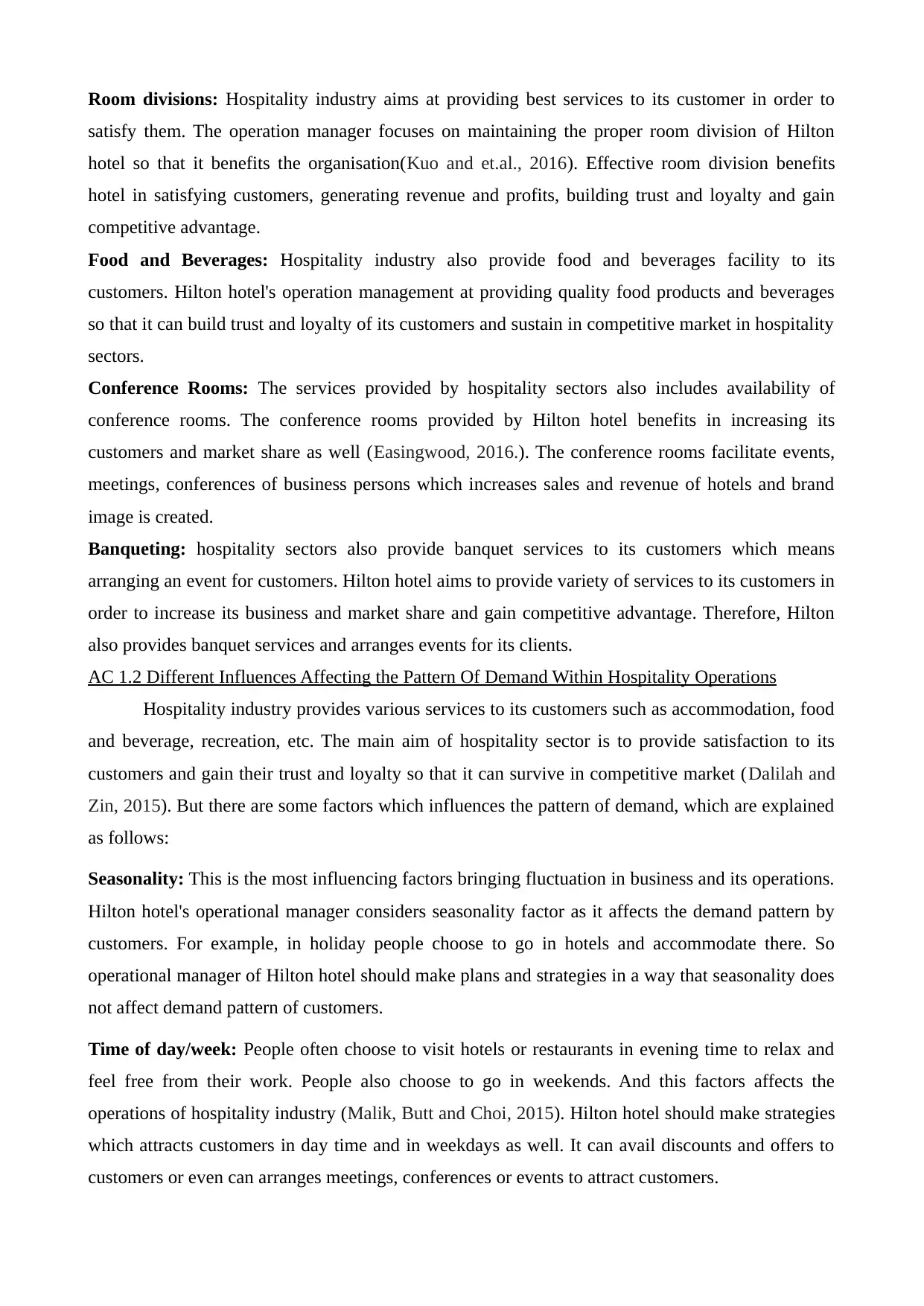
Room divisions: Hospitality industry aims at providing best services to its customer in order to
satisfy them. The operation manager focuses on maintaining the proper room division of Hilton
hotel so that it benefits the organisation(Kuo and et.al., 2016). Effective room division benefits
hotel in satisfying customers, generating revenue and profits, building trust and loyalty and gain
competitive advantage.
Food and Beverages: Hospitality industry also provide food and beverages facility to its
customers. Hilton hotel's operation management at providing quality food products and beverages
so that it can build trust and loyalty of its customers and sustain in competitive market in hospitality
sectors.
Conference Rooms: The services provided by hospitality sectors also includes availability of
conference rooms. The conference rooms provided by Hilton hotel benefits in increasing its
customers and market share as well (Easingwood, 2016.). The conference rooms facilitate events,
meetings, conferences of business persons which increases sales and revenue of hotels and brand
image is created.
Banqueting: hospitality sectors also provide banquet services to its customers which means
arranging an event for customers. Hilton hotel aims to provide variety of services to its customers in
order to increase its business and market share and gain competitive advantage. Therefore, Hilton
also provides banquet services and arranges events for its clients.
AC 1.2 Different Influences Affecting the Pattern Of Demand Within Hospitality Operations
Hospitality industry provides various services to its customers such as accommodation, food
and beverage, recreation, etc. The main aim of hospitality sector is to provide satisfaction to its
customers and gain their trust and loyalty so that it can survive in competitive market (Dalilah and
Zin, 2015). But there are some factors which influences the pattern of demand, which are explained
as follows:
Seasonality: This is the most influencing factors bringing fluctuation in business and its operations.
Hilton hotel's operational manager considers seasonality factor as it affects the demand pattern by
customers. For example, in holiday people choose to go in hotels and accommodate there. So
operational manager of Hilton hotel should make plans and strategies in a way that seasonality does
not affect demand pattern of customers.
Time of day/week: People often choose to visit hotels or restaurants in evening time to relax and
feel free from their work. People also choose to go in weekends. And this factors affects the
operations of hospitality industry (Malik, Butt and Choi, 2015). Hilton hotel should make strategies
which attracts customers in day time and in weekdays as well. It can avail discounts and offers to
customers or even can arranges meetings, conferences or events to attract customers.
satisfy them. The operation manager focuses on maintaining the proper room division of Hilton
hotel so that it benefits the organisation(Kuo and et.al., 2016). Effective room division benefits
hotel in satisfying customers, generating revenue and profits, building trust and loyalty and gain
competitive advantage.
Food and Beverages: Hospitality industry also provide food and beverages facility to its
customers. Hilton hotel's operation management at providing quality food products and beverages
so that it can build trust and loyalty of its customers and sustain in competitive market in hospitality
sectors.
Conference Rooms: The services provided by hospitality sectors also includes availability of
conference rooms. The conference rooms provided by Hilton hotel benefits in increasing its
customers and market share as well (Easingwood, 2016.). The conference rooms facilitate events,
meetings, conferences of business persons which increases sales and revenue of hotels and brand
image is created.
Banqueting: hospitality sectors also provide banquet services to its customers which means
arranging an event for customers. Hilton hotel aims to provide variety of services to its customers in
order to increase its business and market share and gain competitive advantage. Therefore, Hilton
also provides banquet services and arranges events for its clients.
AC 1.2 Different Influences Affecting the Pattern Of Demand Within Hospitality Operations
Hospitality industry provides various services to its customers such as accommodation, food
and beverage, recreation, etc. The main aim of hospitality sector is to provide satisfaction to its
customers and gain their trust and loyalty so that it can survive in competitive market (Dalilah and
Zin, 2015). But there are some factors which influences the pattern of demand, which are explained
as follows:
Seasonality: This is the most influencing factors bringing fluctuation in business and its operations.
Hilton hotel's operational manager considers seasonality factor as it affects the demand pattern by
customers. For example, in holiday people choose to go in hotels and accommodate there. So
operational manager of Hilton hotel should make plans and strategies in a way that seasonality does
not affect demand pattern of customers.
Time of day/week: People often choose to visit hotels or restaurants in evening time to relax and
feel free from their work. People also choose to go in weekends. And this factors affects the
operations of hospitality industry (Malik, Butt and Choi, 2015). Hilton hotel should make strategies
which attracts customers in day time and in weekdays as well. It can avail discounts and offers to
customers or even can arranges meetings, conferences or events to attract customers.
Paraphrase This Document
Need a fresh take? Get an instant paraphrase of this document with our AI Paraphraser
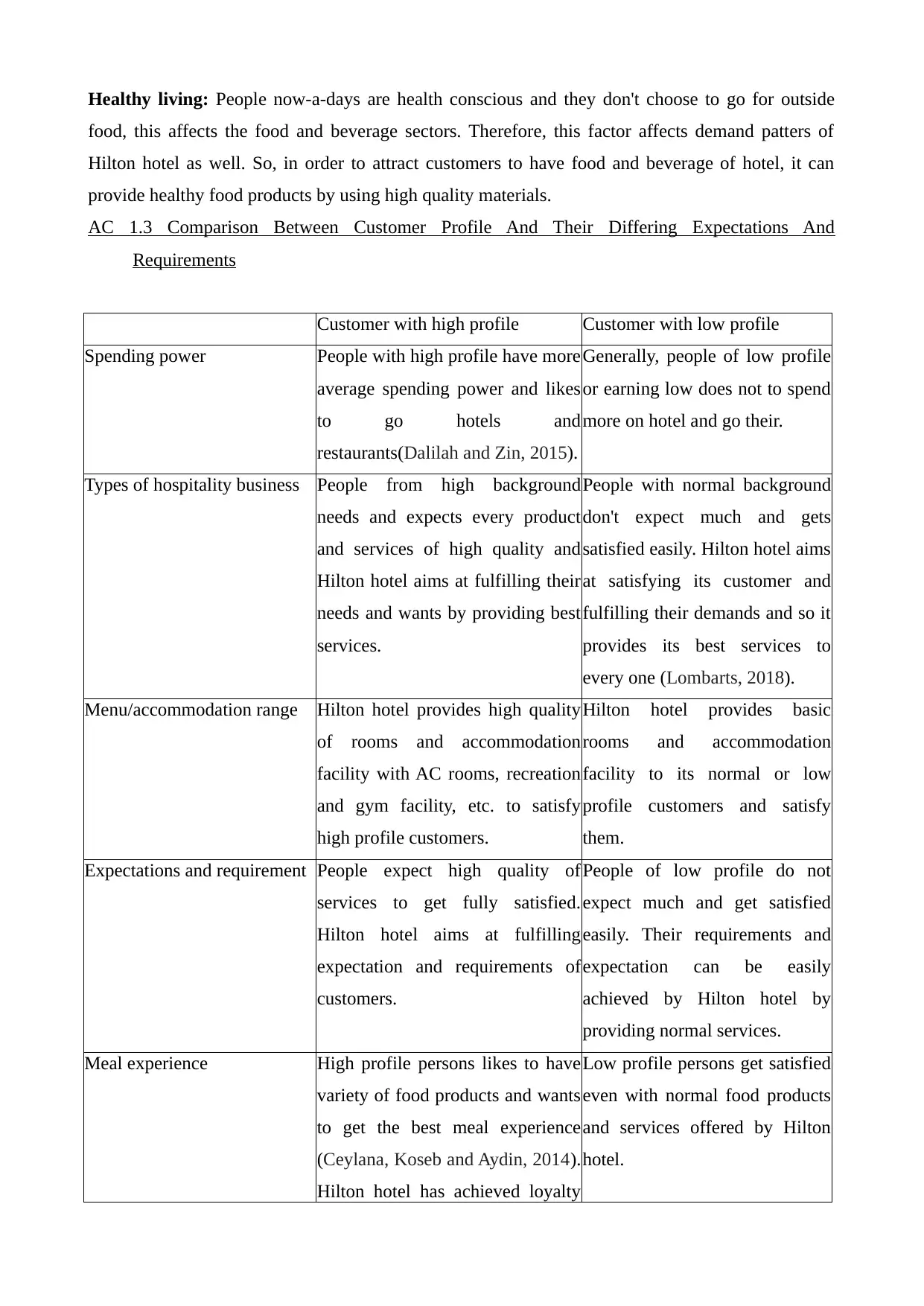
Healthy living: People now-a-days are health conscious and they don't choose to go for outside
food, this affects the food and beverage sectors. Therefore, this factor affects demand patters of
Hilton hotel as well. So, in order to attract customers to have food and beverage of hotel, it can
provide healthy food products by using high quality materials.
AC 1.3 Comparison Between Customer Profile And Their Differing Expectations And
Requirements
Customer with high profile Customer with low profile
Spending power People with high profile have more
average spending power and likes
to go hotels and
restaurants(Dalilah and Zin, 2015).
Generally, people of low profile
or earning low does not to spend
more on hotel and go their.
Types of hospitality business People from high background
needs and expects every product
and services of high quality and
Hilton hotel aims at fulfilling their
needs and wants by providing best
services.
People with normal background
don't expect much and gets
satisfied easily. Hilton hotel aims
at satisfying its customer and
fulfilling their demands and so it
provides its best services to
every one (Lombarts, 2018).
Menu/accommodation range Hilton hotel provides high quality
of rooms and accommodation
facility with AC rooms, recreation
and gym facility, etc. to satisfy
high profile customers.
Hilton hotel provides basic
rooms and accommodation
facility to its normal or low
profile customers and satisfy
them.
Expectations and requirement People expect high quality of
services to get fully satisfied.
Hilton hotel aims at fulfilling
expectation and requirements of
customers.
People of low profile do not
expect much and get satisfied
easily. Their requirements and
expectation can be easily
achieved by Hilton hotel by
providing normal services.
Meal experience High profile persons likes to have
variety of food products and wants
to get the best meal experience
(Ceylana, Koseb and Aydin, 2014).
Hilton hotel has achieved loyalty
Low profile persons get satisfied
even with normal food products
and services offered by Hilton
hotel.
food, this affects the food and beverage sectors. Therefore, this factor affects demand patters of
Hilton hotel as well. So, in order to attract customers to have food and beverage of hotel, it can
provide healthy food products by using high quality materials.
AC 1.3 Comparison Between Customer Profile And Their Differing Expectations And
Requirements
Customer with high profile Customer with low profile
Spending power People with high profile have more
average spending power and likes
to go hotels and
restaurants(Dalilah and Zin, 2015).
Generally, people of low profile
or earning low does not to spend
more on hotel and go their.
Types of hospitality business People from high background
needs and expects every product
and services of high quality and
Hilton hotel aims at fulfilling their
needs and wants by providing best
services.
People with normal background
don't expect much and gets
satisfied easily. Hilton hotel aims
at satisfying its customer and
fulfilling their demands and so it
provides its best services to
every one (Lombarts, 2018).
Menu/accommodation range Hilton hotel provides high quality
of rooms and accommodation
facility with AC rooms, recreation
and gym facility, etc. to satisfy
high profile customers.
Hilton hotel provides basic
rooms and accommodation
facility to its normal or low
profile customers and satisfy
them.
Expectations and requirement People expect high quality of
services to get fully satisfied.
Hilton hotel aims at fulfilling
expectation and requirements of
customers.
People of low profile do not
expect much and get satisfied
easily. Their requirements and
expectation can be easily
achieved by Hilton hotel by
providing normal services.
Meal experience High profile persons likes to have
variety of food products and wants
to get the best meal experience
(Ceylana, Koseb and Aydin, 2014).
Hilton hotel has achieved loyalty
Low profile persons get satisfied
even with normal food products
and services offered by Hilton
hotel.
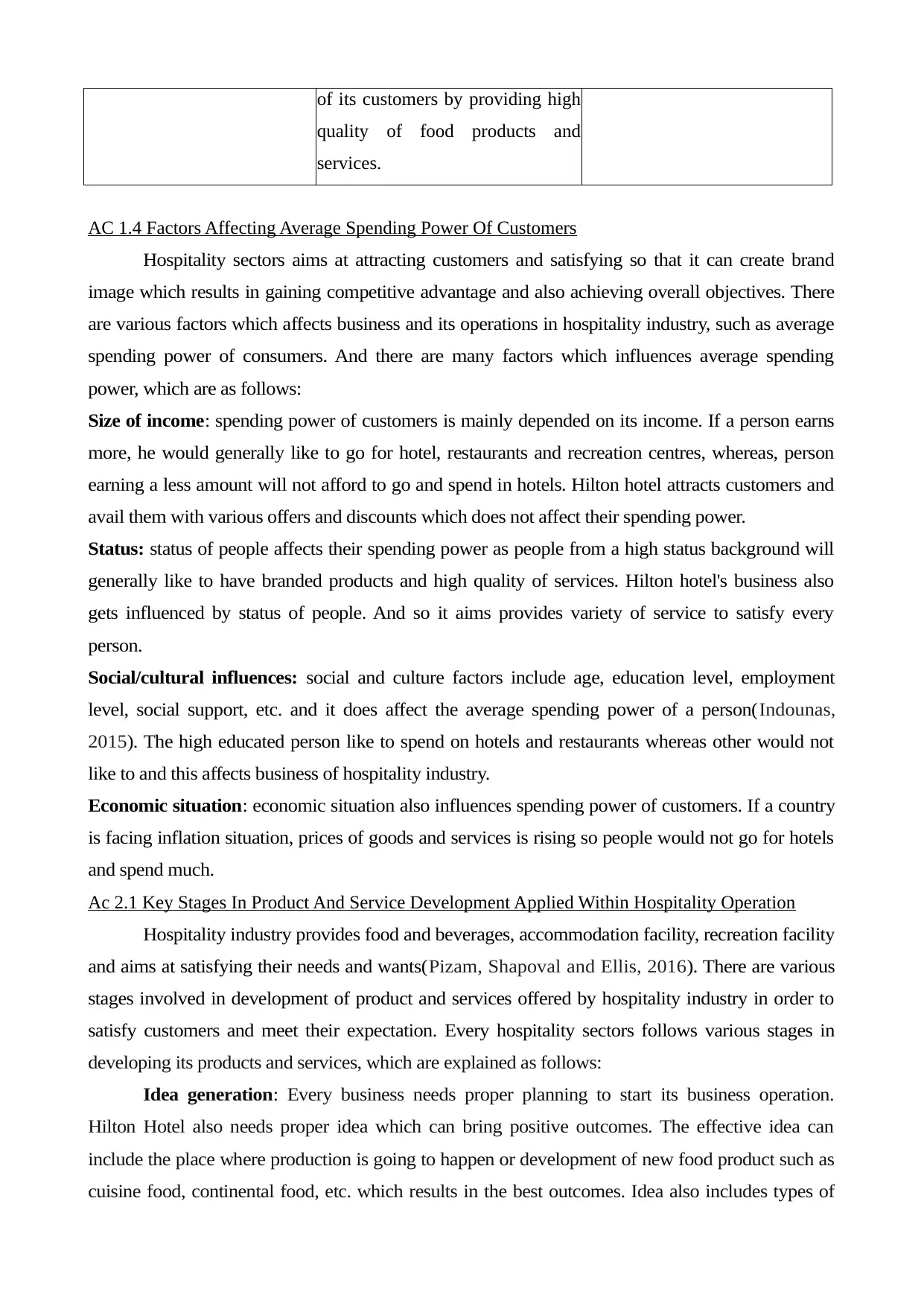
of its customers by providing high
quality of food products and
services.
AC 1.4 Factors Affecting Average Spending Power Of Customers
Hospitality sectors aims at attracting customers and satisfying so that it can create brand
image which results in gaining competitive advantage and also achieving overall objectives. There
are various factors which affects business and its operations in hospitality industry, such as average
spending power of consumers. And there are many factors which influences average spending
power, which are as follows:
Size of income: spending power of customers is mainly depended on its income. If a person earns
more, he would generally like to go for hotel, restaurants and recreation centres, whereas, person
earning a less amount will not afford to go and spend in hotels. Hilton hotel attracts customers and
avail them with various offers and discounts which does not affect their spending power.
Status: status of people affects their spending power as people from a high status background will
generally like to have branded products and high quality of services. Hilton hotel's business also
gets influenced by status of people. And so it aims provides variety of service to satisfy every
person.
Social/cultural influences: social and culture factors include age, education level, employment
level, social support, etc. and it does affect the average spending power of a person(Indounas,
2015). The high educated person like to spend on hotels and restaurants whereas other would not
like to and this affects business of hospitality industry.
Economic situation: economic situation also influences spending power of customers. If a country
is facing inflation situation, prices of goods and services is rising so people would not go for hotels
and spend much.
Ac 2.1 Key Stages In Product And Service Development Applied Within Hospitality Operation
Hospitality industry provides food and beverages, accommodation facility, recreation facility
and aims at satisfying their needs and wants(Pizam, Shapoval and Ellis, 2016). There are various
stages involved in development of product and services offered by hospitality industry in order to
satisfy customers and meet their expectation. Every hospitality sectors follows various stages in
developing its products and services, which are explained as follows:
Idea generation: Every business needs proper planning to start its business operation.
Hilton Hotel also needs proper idea which can bring positive outcomes. The effective idea can
include the place where production is going to happen or development of new food product such as
cuisine food, continental food, etc. which results in the best outcomes. Idea also includes types of
quality of food products and
services.
AC 1.4 Factors Affecting Average Spending Power Of Customers
Hospitality sectors aims at attracting customers and satisfying so that it can create brand
image which results in gaining competitive advantage and also achieving overall objectives. There
are various factors which affects business and its operations in hospitality industry, such as average
spending power of consumers. And there are many factors which influences average spending
power, which are as follows:
Size of income: spending power of customers is mainly depended on its income. If a person earns
more, he would generally like to go for hotel, restaurants and recreation centres, whereas, person
earning a less amount will not afford to go and spend in hotels. Hilton hotel attracts customers and
avail them with various offers and discounts which does not affect their spending power.
Status: status of people affects their spending power as people from a high status background will
generally like to have branded products and high quality of services. Hilton hotel's business also
gets influenced by status of people. And so it aims provides variety of service to satisfy every
person.
Social/cultural influences: social and culture factors include age, education level, employment
level, social support, etc. and it does affect the average spending power of a person(Indounas,
2015). The high educated person like to spend on hotels and restaurants whereas other would not
like to and this affects business of hospitality industry.
Economic situation: economic situation also influences spending power of customers. If a country
is facing inflation situation, prices of goods and services is rising so people would not go for hotels
and spend much.
Ac 2.1 Key Stages In Product And Service Development Applied Within Hospitality Operation
Hospitality industry provides food and beverages, accommodation facility, recreation facility
and aims at satisfying their needs and wants(Pizam, Shapoval and Ellis, 2016). There are various
stages involved in development of product and services offered by hospitality industry in order to
satisfy customers and meet their expectation. Every hospitality sectors follows various stages in
developing its products and services, which are explained as follows:
Idea generation: Every business needs proper planning to start its business operation.
Hilton Hotel also needs proper idea which can bring positive outcomes. The effective idea can
include the place where production is going to happen or development of new food product such as
cuisine food, continental food, etc. which results in the best outcomes. Idea also includes types of
⊘ This is a preview!⊘
Do you want full access?
Subscribe today to unlock all pages.

Trusted by 1+ million students worldwide
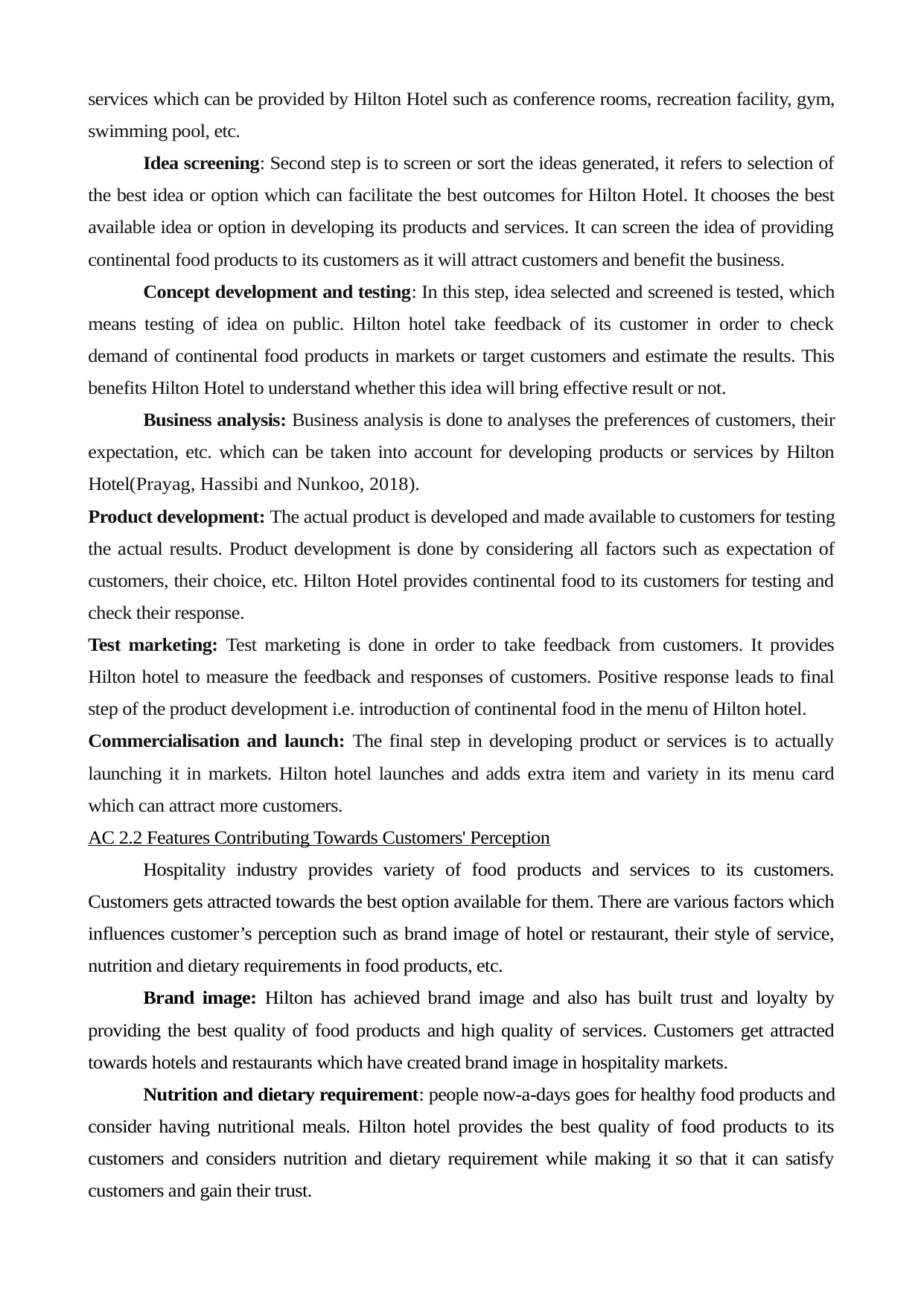
services which can be provided by Hilton Hotel such as conference rooms, recreation facility, gym,
swimming pool, etc.
Idea screening: Second step is to screen or sort the ideas generated, it refers to selection of
the best idea or option which can facilitate the best outcomes for Hilton Hotel. It chooses the best
available idea or option in developing its products and services. It can screen the idea of providing
continental food products to its customers as it will attract customers and benefit the business.
Concept development and testing: In this step, idea selected and screened is tested, which
means testing of idea on public. Hilton hotel take feedback of its customer in order to check
demand of continental food products in markets or target customers and estimate the results. This
benefits Hilton Hotel to understand whether this idea will bring effective result or not.
Business analysis: Business analysis is done to analyses the preferences of customers, their
expectation, etc. which can be taken into account for developing products or services by Hilton
Hotel(Prayag, Hassibi and Nunkoo, 2018).
Product development: The actual product is developed and made available to customers for testing
the actual results. Product development is done by considering all factors such as expectation of
customers, their choice, etc. Hilton Hotel provides continental food to its customers for testing and
check their response.
Test marketing: Test marketing is done in order to take feedback from customers. It provides
Hilton hotel to measure the feedback and responses of customers. Positive response leads to final
step of the product development i.e. introduction of continental food in the menu of Hilton hotel.
Commercialisation and launch: The final step in developing product or services is to actually
launching it in markets. Hilton hotel launches and adds extra item and variety in its menu card
which can attract more customers.
AC 2.2 Features Contributing Towards Customers' Perception
Hospitality industry provides variety of food products and services to its customers.
Customers gets attracted towards the best option available for them. There are various factors which
influences customer’s perception such as brand image of hotel or restaurant, their style of service,
nutrition and dietary requirements in food products, etc.
Brand image: Hilton has achieved brand image and also has built trust and loyalty by
providing the best quality of food products and high quality of services. Customers get attracted
towards hotels and restaurants which have created brand image in hospitality markets.
Nutrition and dietary requirement: people now-a-days goes for healthy food products and
consider having nutritional meals. Hilton hotel provides the best quality of food products to its
customers and considers nutrition and dietary requirement while making it so that it can satisfy
customers and gain their trust.
swimming pool, etc.
Idea screening: Second step is to screen or sort the ideas generated, it refers to selection of
the best idea or option which can facilitate the best outcomes for Hilton Hotel. It chooses the best
available idea or option in developing its products and services. It can screen the idea of providing
continental food products to its customers as it will attract customers and benefit the business.
Concept development and testing: In this step, idea selected and screened is tested, which
means testing of idea on public. Hilton hotel take feedback of its customer in order to check
demand of continental food products in markets or target customers and estimate the results. This
benefits Hilton Hotel to understand whether this idea will bring effective result or not.
Business analysis: Business analysis is done to analyses the preferences of customers, their
expectation, etc. which can be taken into account for developing products or services by Hilton
Hotel(Prayag, Hassibi and Nunkoo, 2018).
Product development: The actual product is developed and made available to customers for testing
the actual results. Product development is done by considering all factors such as expectation of
customers, their choice, etc. Hilton Hotel provides continental food to its customers for testing and
check their response.
Test marketing: Test marketing is done in order to take feedback from customers. It provides
Hilton hotel to measure the feedback and responses of customers. Positive response leads to final
step of the product development i.e. introduction of continental food in the menu of Hilton hotel.
Commercialisation and launch: The final step in developing product or services is to actually
launching it in markets. Hilton hotel launches and adds extra item and variety in its menu card
which can attract more customers.
AC 2.2 Features Contributing Towards Customers' Perception
Hospitality industry provides variety of food products and services to its customers.
Customers gets attracted towards the best option available for them. There are various factors which
influences customer’s perception such as brand image of hotel or restaurant, their style of service,
nutrition and dietary requirements in food products, etc.
Brand image: Hilton has achieved brand image and also has built trust and loyalty by
providing the best quality of food products and high quality of services. Customers get attracted
towards hotels and restaurants which have created brand image in hospitality markets.
Nutrition and dietary requirement: people now-a-days goes for healthy food products and
consider having nutritional meals. Hilton hotel provides the best quality of food products to its
customers and considers nutrition and dietary requirement while making it so that it can satisfy
customers and gain their trust.
Paraphrase This Document
Need a fresh take? Get an instant paraphrase of this document with our AI Paraphraser

Disabled access: Hilton also provides services to disabled persons such as it provides wheel
chairs facility, accelerators, etc.(Colurcio, 2016). Hilton hotel aims at satisfying every customers
and achieve their trust and loyalty.
Availability of resources: people look for variety of services provided by hotels and
restaurant and accordingly selects it. Services provided by hotels include gym, recreation,
swimming pool, spa, etc. which influences perception of customers.
Style of services: people like to feel special and get special experience. Hilton hotel aims at
providing high quality of services in order to make customers happy and satisfied(Weng and et.al.,
2016). Style of services reflects status of hotels and it also helps to influence customer's perception
and attract them.
Standardisation and space utilisation: The space utilized and its standard also influences
perception of customers in hospitality industry. Hilton hotel has utilized a large space and created a
high level of standard which attracts customers.
AC2.3 Opportunities and Barriers In Product Development Service In The Hospitality Organisation
Opportunities here includes factors which increase the profitability in the HILTON organisation.
Consumer segmentation. To develop the demand of product entity, have to identify the
factors which satisfy consumer satisfaction. Two variables in this can be affected that is Hard
variable and soft variable. Hard variable includes age, gender, education level, and level of income.
Soft variable includes lifestyle, attitude, and purchasing motivation.
Purchase analysis. This types of opportunities includes the purchasing power of the
consumers. Like if they visit hotel then their affordability to buy services with the price they afford.
Offering some discounts may attract more consumer in the hotel and digital payment option also
helpful in attracting new customer in the organisation.
Complementary product and service. Complimentary service includes trends in market is
to be considered while taking investment decision. Here it includes which product to develop that
increase the profitability of the company(Wang and Ming, 2018).
Company makes product to fulfils the needs and wants of the customer but the problem
arises when company has to face the challenges which creating problem to launch the product.
Some challenges are.
Social challenge. Different country has different needs and wants which is according to their
economic development. Countries has different food culture which company cannot launched
according to individual need this makes challenge in launching new products.
Legal challenges. Company have to face the legal challenges because every product of
company was not accordance with every country some countries may have restrictions on eating
food items which every company has to face while launching.
chairs facility, accelerators, etc.(Colurcio, 2016). Hilton hotel aims at satisfying every customers
and achieve their trust and loyalty.
Availability of resources: people look for variety of services provided by hotels and
restaurant and accordingly selects it. Services provided by hotels include gym, recreation,
swimming pool, spa, etc. which influences perception of customers.
Style of services: people like to feel special and get special experience. Hilton hotel aims at
providing high quality of services in order to make customers happy and satisfied(Weng and et.al.,
2016). Style of services reflects status of hotels and it also helps to influence customer's perception
and attract them.
Standardisation and space utilisation: The space utilized and its standard also influences
perception of customers in hospitality industry. Hilton hotel has utilized a large space and created a
high level of standard which attracts customers.
AC2.3 Opportunities and Barriers In Product Development Service In The Hospitality Organisation
Opportunities here includes factors which increase the profitability in the HILTON organisation.
Consumer segmentation. To develop the demand of product entity, have to identify the
factors which satisfy consumer satisfaction. Two variables in this can be affected that is Hard
variable and soft variable. Hard variable includes age, gender, education level, and level of income.
Soft variable includes lifestyle, attitude, and purchasing motivation.
Purchase analysis. This types of opportunities includes the purchasing power of the
consumers. Like if they visit hotel then their affordability to buy services with the price they afford.
Offering some discounts may attract more consumer in the hotel and digital payment option also
helpful in attracting new customer in the organisation.
Complementary product and service. Complimentary service includes trends in market is
to be considered while taking investment decision. Here it includes which product to develop that
increase the profitability of the company(Wang and Ming, 2018).
Company makes product to fulfils the needs and wants of the customer but the problem
arises when company has to face the challenges which creating problem to launch the product.
Some challenges are.
Social challenge. Different country has different needs and wants which is according to their
economic development. Countries has different food culture which company cannot launched
according to individual need this makes challenge in launching new products.
Legal challenges. Company have to face the legal challenges because every product of
company was not accordance with every country some countries may have restrictions on eating
food items which every company has to face while launching.
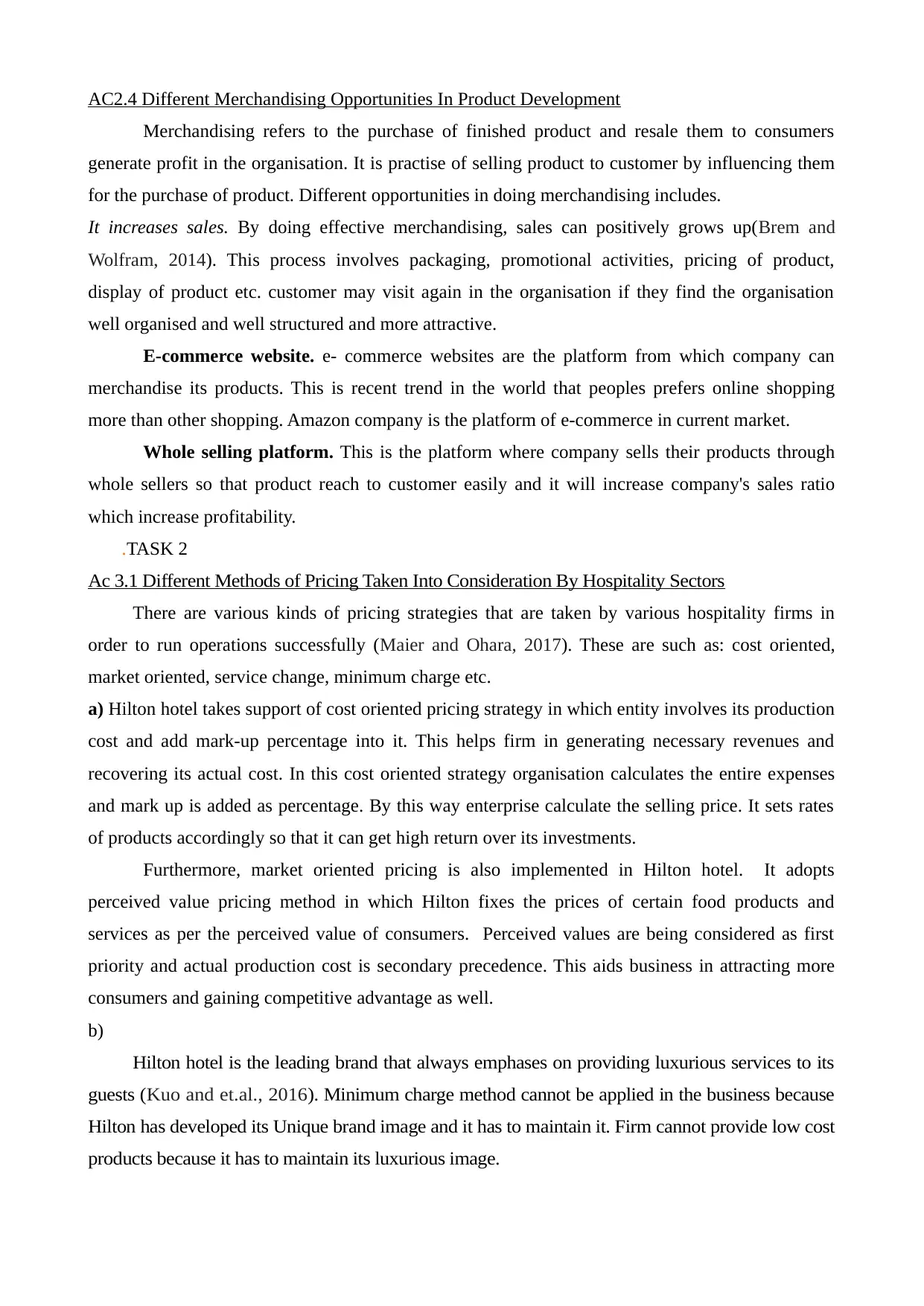
AC2.4 Different Merchandising Opportunities In Product Development
Merchandising refers to the purchase of finished product and resale them to consumers
generate profit in the organisation. It is practise of selling product to customer by influencing them
for the purchase of product. Different opportunities in doing merchandising includes.
It increases sales. By doing effective merchandising, sales can positively grows up(Brem and
Wolfram, 2014). This process involves packaging, promotional activities, pricing of product,
display of product etc. customer may visit again in the organisation if they find the organisation
well organised and well structured and more attractive.
E-commerce website. e- commerce websites are the platform from which company can
merchandise its products. This is recent trend in the world that peoples prefers online shopping
more than other shopping. Amazon company is the platform of e-commerce in current market.
Whole selling platform. This is the platform where company sells their products through
whole sellers so that product reach to customer easily and it will increase company's sales ratio
which increase profitability.
.TASK 2
Ac 3.1 Different Methods of Pricing Taken Into Consideration By Hospitality Sectors
There are various kinds of pricing strategies that are taken by various hospitality firms in
order to run operations successfully (Maier and Ohara, 2017). These are such as: cost oriented,
market oriented, service change, minimum charge etc.
a) Hilton hotel takes support of cost oriented pricing strategy in which entity involves its production
cost and add mark-up percentage into it. This helps firm in generating necessary revenues and
recovering its actual cost. In this cost oriented strategy organisation calculates the entire expenses
and mark up is added as percentage. By this way enterprise calculate the selling price. It sets rates
of products accordingly so that it can get high return over its investments.
Furthermore, market oriented pricing is also implemented in Hilton hotel. It adopts
perceived value pricing method in which Hilton fixes the prices of certain food products and
services as per the perceived value of consumers. Perceived values are being considered as first
priority and actual production cost is secondary precedence. This aids business in attracting more
consumers and gaining competitive advantage as well.
b)
Hilton hotel is the leading brand that always emphases on providing luxurious services to its
guests (Kuo and et.al., 2016). Minimum charge method cannot be applied in the business because
Hilton has developed its Unique brand image and it has to maintain it. Firm cannot provide low cost
products because it has to maintain its luxurious image.
Merchandising refers to the purchase of finished product and resale them to consumers
generate profit in the organisation. It is practise of selling product to customer by influencing them
for the purchase of product. Different opportunities in doing merchandising includes.
It increases sales. By doing effective merchandising, sales can positively grows up(Brem and
Wolfram, 2014). This process involves packaging, promotional activities, pricing of product,
display of product etc. customer may visit again in the organisation if they find the organisation
well organised and well structured and more attractive.
E-commerce website. e- commerce websites are the platform from which company can
merchandise its products. This is recent trend in the world that peoples prefers online shopping
more than other shopping. Amazon company is the platform of e-commerce in current market.
Whole selling platform. This is the platform where company sells their products through
whole sellers so that product reach to customer easily and it will increase company's sales ratio
which increase profitability.
.TASK 2
Ac 3.1 Different Methods of Pricing Taken Into Consideration By Hospitality Sectors
There are various kinds of pricing strategies that are taken by various hospitality firms in
order to run operations successfully (Maier and Ohara, 2017). These are such as: cost oriented,
market oriented, service change, minimum charge etc.
a) Hilton hotel takes support of cost oriented pricing strategy in which entity involves its production
cost and add mark-up percentage into it. This helps firm in generating necessary revenues and
recovering its actual cost. In this cost oriented strategy organisation calculates the entire expenses
and mark up is added as percentage. By this way enterprise calculate the selling price. It sets rates
of products accordingly so that it can get high return over its investments.
Furthermore, market oriented pricing is also implemented in Hilton hotel. It adopts
perceived value pricing method in which Hilton fixes the prices of certain food products and
services as per the perceived value of consumers. Perceived values are being considered as first
priority and actual production cost is secondary precedence. This aids business in attracting more
consumers and gaining competitive advantage as well.
b)
Hilton hotel is the leading brand that always emphases on providing luxurious services to its
guests (Kuo and et.al., 2016). Minimum charge method cannot be applied in the business because
Hilton has developed its Unique brand image and it has to maintain it. Firm cannot provide low cost
products because it has to maintain its luxurious image.
⊘ This is a preview!⊘
Do you want full access?
Subscribe today to unlock all pages.

Trusted by 1+ million students worldwide
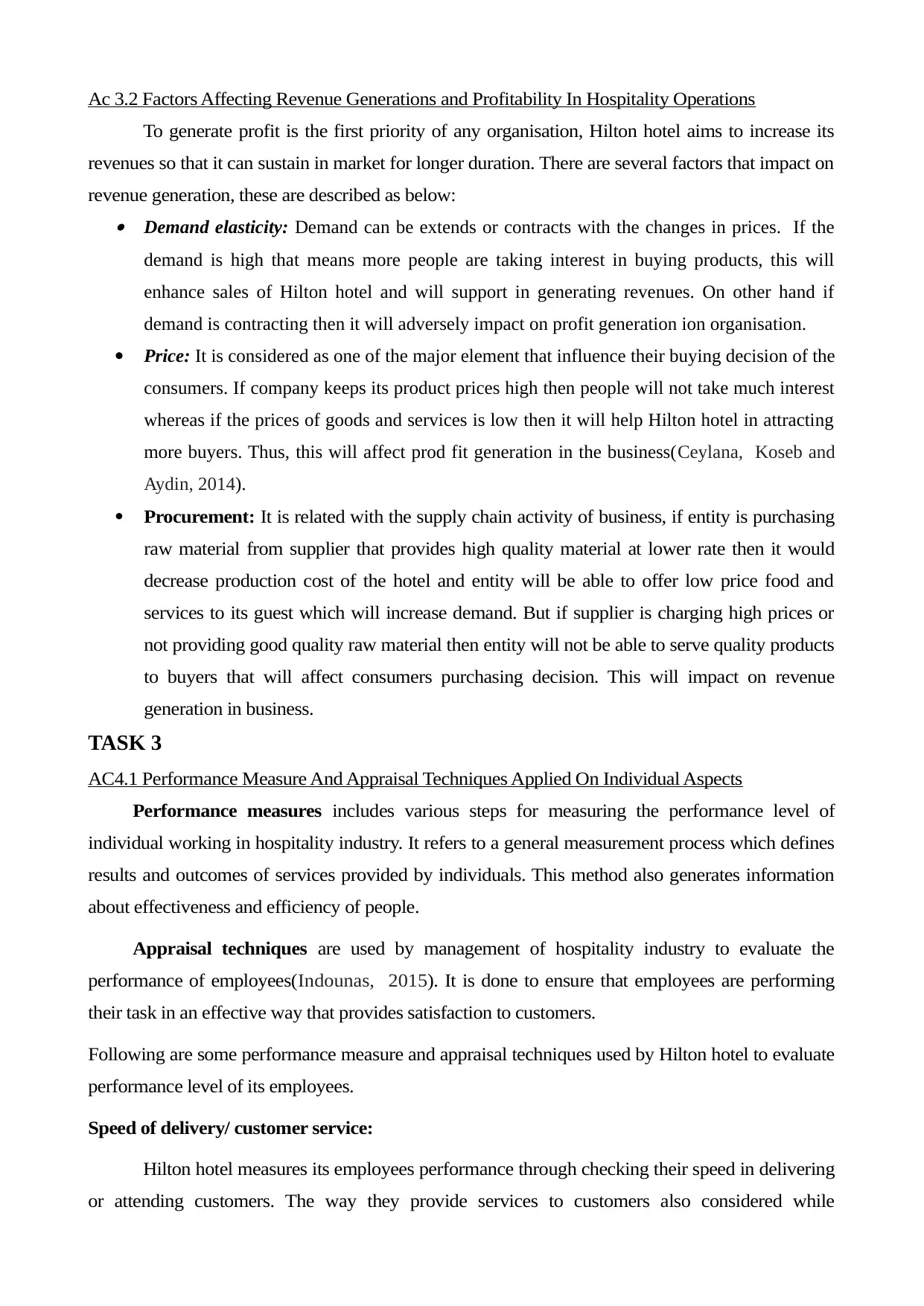
Ac 3.2 Factors Affecting Revenue Generations and Profitability In Hospitality Operations
To generate profit is the first priority of any organisation, Hilton hotel aims to increase its
revenues so that it can sustain in market for longer duration. There are several factors that impact on
revenue generation, these are described as below:
Demand elasticity: Demand can be extends or contracts with the changes in prices. If the
demand is high that means more people are taking interest in buying products, this will
enhance sales of Hilton hotel and will support in generating revenues. On other hand if
demand is contracting then it will adversely impact on profit generation ion organisation.
Price: It is considered as one of the major element that influence their buying decision of the
consumers. If company keeps its product prices high then people will not take much interest
whereas if the prices of goods and services is low then it will help Hilton hotel in attracting
more buyers. Thus, this will affect prod fit generation in the business(Ceylana, Koseb and
Aydin, 2014).
Procurement: It is related with the supply chain activity of business, if entity is purchasing
raw material from supplier that provides high quality material at lower rate then it would
decrease production cost of the hotel and entity will be able to offer low price food and
services to its guest which will increase demand. But if supplier is charging high prices or
not providing good quality raw material then entity will not be able to serve quality products
to buyers that will affect consumers purchasing decision. This will impact on revenue
generation in business.
TASK 3
AC4.1 Performance Measure And Appraisal Techniques Applied On Individual Aspects
Performance measures includes various steps for measuring the performance level of
individual working in hospitality industry. It refers to a general measurement process which defines
results and outcomes of services provided by individuals. This method also generates information
about effectiveness and efficiency of people.
Appraisal techniques are used by management of hospitality industry to evaluate the
performance of employees(Indounas, 2015). It is done to ensure that employees are performing
their task in an effective way that provides satisfaction to customers.
Following are some performance measure and appraisal techniques used by Hilton hotel to evaluate
performance level of its employees.
Speed of delivery/ customer service:
Hilton hotel measures its employees performance through checking their speed in delivering
or attending customers. The way they provide services to customers also considered while
To generate profit is the first priority of any organisation, Hilton hotel aims to increase its
revenues so that it can sustain in market for longer duration. There are several factors that impact on
revenue generation, these are described as below:
Demand elasticity: Demand can be extends or contracts with the changes in prices. If the
demand is high that means more people are taking interest in buying products, this will
enhance sales of Hilton hotel and will support in generating revenues. On other hand if
demand is contracting then it will adversely impact on profit generation ion organisation.
Price: It is considered as one of the major element that influence their buying decision of the
consumers. If company keeps its product prices high then people will not take much interest
whereas if the prices of goods and services is low then it will help Hilton hotel in attracting
more buyers. Thus, this will affect prod fit generation in the business(Ceylana, Koseb and
Aydin, 2014).
Procurement: It is related with the supply chain activity of business, if entity is purchasing
raw material from supplier that provides high quality material at lower rate then it would
decrease production cost of the hotel and entity will be able to offer low price food and
services to its guest which will increase demand. But if supplier is charging high prices or
not providing good quality raw material then entity will not be able to serve quality products
to buyers that will affect consumers purchasing decision. This will impact on revenue
generation in business.
TASK 3
AC4.1 Performance Measure And Appraisal Techniques Applied On Individual Aspects
Performance measures includes various steps for measuring the performance level of
individual working in hospitality industry. It refers to a general measurement process which defines
results and outcomes of services provided by individuals. This method also generates information
about effectiveness and efficiency of people.
Appraisal techniques are used by management of hospitality industry to evaluate the
performance of employees(Indounas, 2015). It is done to ensure that employees are performing
their task in an effective way that provides satisfaction to customers.
Following are some performance measure and appraisal techniques used by Hilton hotel to evaluate
performance level of its employees.
Speed of delivery/ customer service:
Hilton hotel measures its employees performance through checking their speed in delivering
or attending customers. The way they provide services to customers also considered while
Paraphrase This Document
Need a fresh take? Get an instant paraphrase of this document with our AI Paraphraser
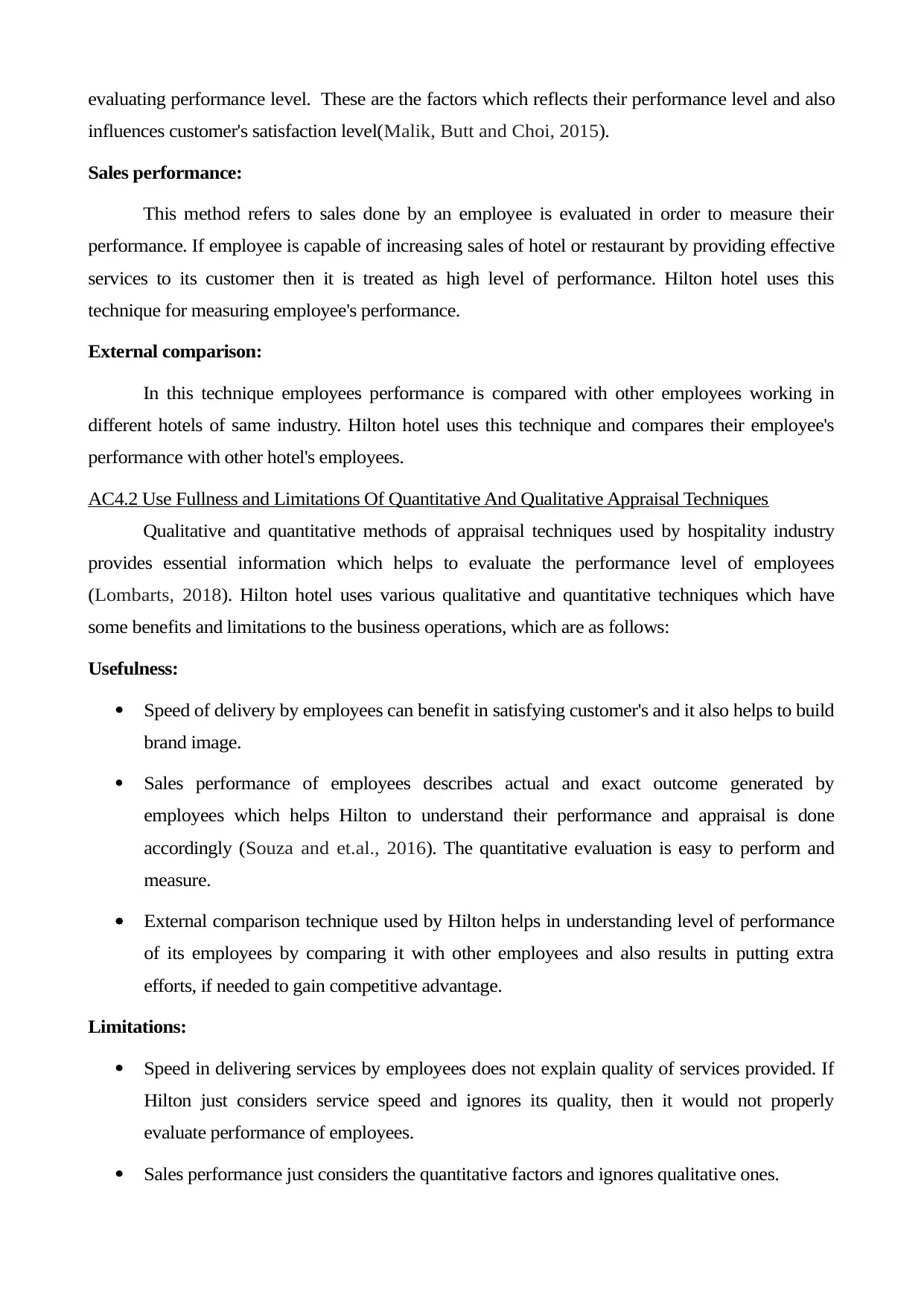
evaluating performance level. These are the factors which reflects their performance level and also
influences customer's satisfaction level(Malik, Butt and Choi, 2015).
Sales performance:
This method refers to sales done by an employee is evaluated in order to measure their
performance. If employee is capable of increasing sales of hotel or restaurant by providing effective
services to its customer then it is treated as high level of performance. Hilton hotel uses this
technique for measuring employee's performance.
External comparison:
In this technique employees performance is compared with other employees working in
different hotels of same industry. Hilton hotel uses this technique and compares their employee's
performance with other hotel's employees.
AC4.2 Use Fullness and Limitations Of Quantitative And Qualitative Appraisal Techniques
Qualitative and quantitative methods of appraisal techniques used by hospitality industry
provides essential information which helps to evaluate the performance level of employees
(Lombarts, 2018). Hilton hotel uses various qualitative and quantitative techniques which have
some benefits and limitations to the business operations, which are as follows:
Usefulness:
Speed of delivery by employees can benefit in satisfying customer's and it also helps to build
brand image.
Sales performance of employees describes actual and exact outcome generated by
employees which helps Hilton to understand their performance and appraisal is done
accordingly (Souza and et.al., 2016). The quantitative evaluation is easy to perform and
measure.
External comparison technique used by Hilton helps in understanding level of performance
of its employees by comparing it with other employees and also results in putting extra
efforts, if needed to gain competitive advantage.
Limitations:
Speed in delivering services by employees does not explain quality of services provided. If
Hilton just considers service speed and ignores its quality, then it would not properly
evaluate performance of employees.
Sales performance just considers the quantitative factors and ignores qualitative ones.
influences customer's satisfaction level(Malik, Butt and Choi, 2015).
Sales performance:
This method refers to sales done by an employee is evaluated in order to measure their
performance. If employee is capable of increasing sales of hotel or restaurant by providing effective
services to its customer then it is treated as high level of performance. Hilton hotel uses this
technique for measuring employee's performance.
External comparison:
In this technique employees performance is compared with other employees working in
different hotels of same industry. Hilton hotel uses this technique and compares their employee's
performance with other hotel's employees.
AC4.2 Use Fullness and Limitations Of Quantitative And Qualitative Appraisal Techniques
Qualitative and quantitative methods of appraisal techniques used by hospitality industry
provides essential information which helps to evaluate the performance level of employees
(Lombarts, 2018). Hilton hotel uses various qualitative and quantitative techniques which have
some benefits and limitations to the business operations, which are as follows:
Usefulness:
Speed of delivery by employees can benefit in satisfying customer's and it also helps to build
brand image.
Sales performance of employees describes actual and exact outcome generated by
employees which helps Hilton to understand their performance and appraisal is done
accordingly (Souza and et.al., 2016). The quantitative evaluation is easy to perform and
measure.
External comparison technique used by Hilton helps in understanding level of performance
of its employees by comparing it with other employees and also results in putting extra
efforts, if needed to gain competitive advantage.
Limitations:
Speed in delivering services by employees does not explain quality of services provided. If
Hilton just considers service speed and ignores its quality, then it would not properly
evaluate performance of employees.
Sales performance just considers the quantitative factors and ignores qualitative ones.
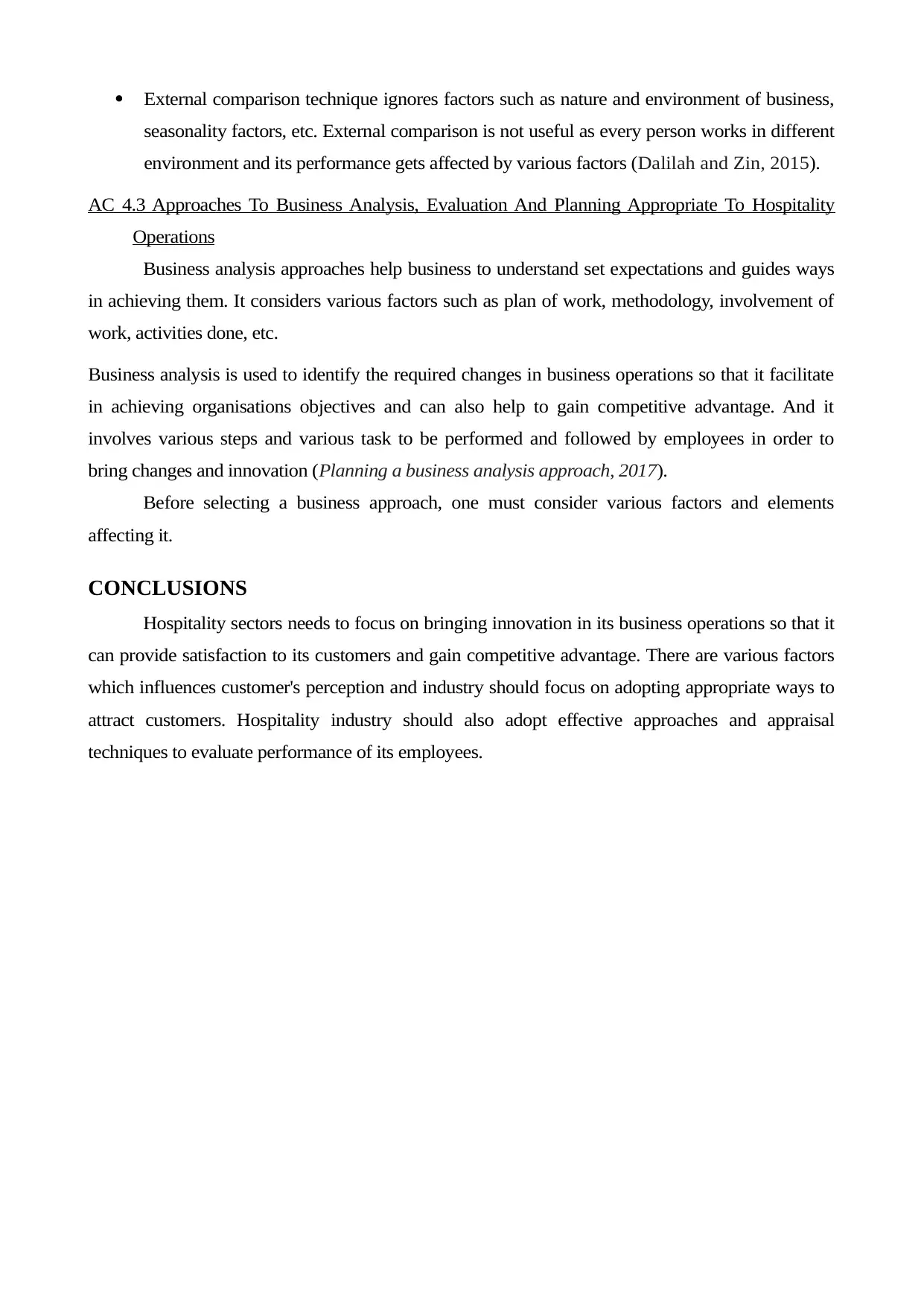
External comparison technique ignores factors such as nature and environment of business,
seasonality factors, etc. External comparison is not useful as every person works in different
environment and its performance gets affected by various factors (Dalilah and Zin, 2015).
AC 4.3 Approaches To Business Analysis, Evaluation And Planning Appropriate To Hospitality
Operations
Business analysis approaches help business to understand set expectations and guides ways
in achieving them. It considers various factors such as plan of work, methodology, involvement of
work, activities done, etc.
Business analysis is used to identify the required changes in business operations so that it facilitate
in achieving organisations objectives and can also help to gain competitive advantage. And it
involves various steps and various task to be performed and followed by employees in order to
bring changes and innovation (Planning a business analysis approach, 2017).
Before selecting a business approach, one must consider various factors and elements
affecting it.
CONCLUSIONS
Hospitality sectors needs to focus on bringing innovation in its business operations so that it
can provide satisfaction to its customers and gain competitive advantage. There are various factors
which influences customer's perception and industry should focus on adopting appropriate ways to
attract customers. Hospitality industry should also adopt effective approaches and appraisal
techniques to evaluate performance of its employees.
seasonality factors, etc. External comparison is not useful as every person works in different
environment and its performance gets affected by various factors (Dalilah and Zin, 2015).
AC 4.3 Approaches To Business Analysis, Evaluation And Planning Appropriate To Hospitality
Operations
Business analysis approaches help business to understand set expectations and guides ways
in achieving them. It considers various factors such as plan of work, methodology, involvement of
work, activities done, etc.
Business analysis is used to identify the required changes in business operations so that it facilitate
in achieving organisations objectives and can also help to gain competitive advantage. And it
involves various steps and various task to be performed and followed by employees in order to
bring changes and innovation (Planning a business analysis approach, 2017).
Before selecting a business approach, one must consider various factors and elements
affecting it.
CONCLUSIONS
Hospitality sectors needs to focus on bringing innovation in its business operations so that it
can provide satisfaction to its customers and gain competitive advantage. There are various factors
which influences customer's perception and industry should focus on adopting appropriate ways to
attract customers. Hospitality industry should also adopt effective approaches and appraisal
techniques to evaluate performance of its employees.
⊘ This is a preview!⊘
Do you want full access?
Subscribe today to unlock all pages.

Trusted by 1+ million students worldwide
1 out of 13
Related Documents
Your All-in-One AI-Powered Toolkit for Academic Success.
+13062052269
info@desklib.com
Available 24*7 on WhatsApp / Email
![[object Object]](/_next/static/media/star-bottom.7253800d.svg)
Unlock your academic potential
Copyright © 2020–2025 A2Z Services. All Rights Reserved. Developed and managed by ZUCOL.





